Trên đường thẳng MN lấy điểm P sao cho →MN=−3→MP. Điểm P được xác định đúng trong hình vẽ nào sau đây:

Ta có →MN=−3→MP nên MN=3MP và→MN và →MP ngược hướng.
Hãy chọn kết quả đúng khi phân tích vectơ →AM theo hai véctơ →ABvà→AC của tam giác ABC với trung tuyến AM.
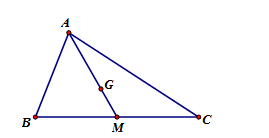
Do M là trung điểm của BCnên ta có →AM=12(→AB+→AC).
Nếu G là trọng tam giác ABC thì đẳng thức nào sau đây đúng.
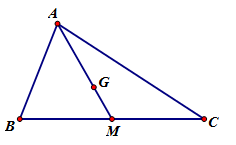
Gọi M là trung điểm của BC nên ta có
→AB+→AC=2→AM
Mà →AM=32→AG⇒→AB+→AC=2.32→AG=3→AG⇒→AG=→AB+→AC3.
Đẳng thức nào sau đây mô tả đúng hình vẽ bên:

Ta có AB=3AI;→AI và →AB ngược hướng nên →AB=−3→AI⇔3→AI+→AB=→0
Vậy 3→AI+→AB=→0.
Cho hình vuông ABCD cạnh a√2. TínhS=|2→AD+→DB|?

Ta có
S=|2→AD+→DB|=|→AD+→AD+→DB|=|→AD+→AB|=|→AC|=a√2.√2=2a.
Phát biểu nào là sai?
→AB=→CD thì [AB//CDAB≡CD.
Nên đáp án B SAI.
Cho hai tam giác ABC và A′B′C′ lần lượt có trọng tâm là G và G′. Đẳng thức nào sau đây là sai?
Do G và G′ lần lượt là trọng tâm của tam giác ABCvà A′B′C′ nên
→AG+→BG+→CG=→0 và →A′G′+→B′G′+→C′G′=→0
Đáp án A: →AA′+→BB′+→CC′=(→AG+→BG+→CG)+(→GA′+→GB′+→GC′)=→0+3→GG′
Đáp án B: →AB′+→BC′+→CA′=(→AG+→BG+→CG)+(→GA′+→GB′+→GC′)=→0+3→GG′
Đáp án C: →AC′+→BA′+→CB′=(→AG+→BG+→CG)+(→GA′+→GB′+→GC′)=→0+3→GG′
Đáp án D: →A′A+→B′B+→C′C=(→A′G′+→B′G′+→C′G′)+(→G′A+→G′B+→G′C)=→0+3→G′G (SAI)
Cho hai vectơ →a và →b không cùng phương. Hai vectơ nào sau đây cùng phương?
Ta có12→a−→b=−(−12→a+→b) nên chọn đáp án C.
Biết rằng hai vec tơ →a và →b không cùng phương nhưng hai vec tơ 2→a−3→b và →a+(x−1)→b cùng phương. Khi đó giá trị của x là:
Ta có 2→a−3→b và →a+(x−1)→b cùng phương nên có tỉ lệ:12=x−1−3⇒x=−12.
Cho tam giác ABC, điểm M thoả mãn: 5→MA=2→MB. Với mỗi điểm I bất kì, nếu →IA=m→IM+n→IB thì cặp số (m;n) bằng:
Ta có
5→MA=2→MB⇔5(→MI+→IA)=2(→MI+→IB)⇔5→IA=3→IM+2→IB⇔→IA=35→IM+25→IB
Cho tam giác ABC. Gọi M là điểm trên cạnh BC sao cho MB=3MC. Khi đó, biễu diễn →AM theo →AB và →AC là:
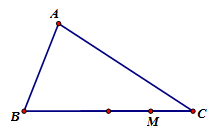
Ta có:
\overrightarrow {AM} = \overrightarrow {AB} + \overrightarrow {BM} = \overrightarrow {AB} + \dfrac{3}{4}\overrightarrow {BC} = \overrightarrow {AB} + \dfrac{3}{4}\left( {\overrightarrow {BA} + \overrightarrow {AC} } \right) = \dfrac{1}{4}\overrightarrow {AB} + \dfrac{3}{4}\overrightarrow {AC}
Cho tam giác ABC có M thuộc cạnh BC sao cho CM{\rm{ }} = {\rm{ }}2MB và I là trung điểm củaAB. Đẳng thức nào sau đây đúng?
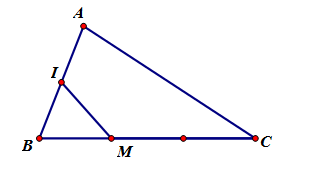
Ta có
\overrightarrow {IM} = \overrightarrow {IB} + \overrightarrow {BM} = \dfrac{1}{2}\overrightarrow {AB} + \dfrac{1}{3}\overrightarrow {BC} = \dfrac{1}{2}\overrightarrow {AB} + \dfrac{1}{3}\left( {\overrightarrow {AC} - \overrightarrow {AB} } \right) = \dfrac{1}{6}\overrightarrow {AB} + \dfrac{1}{3}\overrightarrow {AC} .
Cho hai điểm cố định A,B; gọi I là trung điểm AB. Tập hợp các điểm M thoả: \left| {\overrightarrow {MA} + \overrightarrow {MB} } \right| = \left| {\overrightarrow {MA} - \overrightarrow {MB} } \right| là:
Ta có \left| {\overrightarrow {MA} + \overrightarrow {MB} } \right| = \left| {\overrightarrow {MA} - \overrightarrow {MB} } \right| \Leftrightarrow \left| {2\overrightarrow {MI} } \right| = \left| {\overrightarrow {BA} } \right| \Leftrightarrow 2MI = BA \Leftrightarrow MI = \dfrac{{BA}}{2}
Vậy tập hợp các điểm M là đường tròn đường kính AB.
Tam giác ABC vuông tại A,{\rm{ }}AB = AC = 2. Độ dài vectơ 4\overrightarrow {AB} - \overrightarrow {AC} bằng:
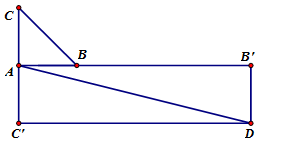
Vẽ \overrightarrow {AB'} = 4\overrightarrow {AB} ;\,\,\,\,\,\,\overrightarrow {AC'} = - \overrightarrow {AC} . Vẽ hình bình hành AC'DB'
Ta có: \left| {4\overrightarrow {AB} - \overrightarrow {AC} } \right| = \left| {\overrightarrow {AB'} + \overrightarrow {AC'} } \right| = \left| {\overrightarrow {AD} } \right| = AD
Do đó AD = \sqrt {A{{B'}^2} + A{{C'}^2}} = \sqrt {{8^2} + {2^2}} = 2\sqrt {17} .
Cho tam giác đều ABC cạnh a. Biết rằng tập hợp các điểm M thỏa mãn đẳng thức \left| {2\overrightarrow {MA} + 3\overrightarrow {MB} + 4\overrightarrow {MC} } \right| = \left| {\overrightarrow {MB} - \overrightarrow {MA} } \right| là đường tròn cố định có bán kính R. Tính bán kính R theo a.
Gọi G là trọng tâm của tam giác ABC.
Ta có 2\overrightarrow {MA} + 3\overrightarrow {MB} + 4\overrightarrow {MC} = 2\left( {\overrightarrow {MI} + \overrightarrow {IA} } \right) + 3\left( {\overrightarrow {MI} + \overrightarrow {IB} } \right) + 4\left( {\overrightarrow {MI} + \overrightarrow {IC} } \right)
Chọn điểm I sao cho 2\overrightarrow {IA} + 3\overrightarrow {IB} + 4\overrightarrow {IC} = \overrightarrow 0 \Leftrightarrow 3\left( {\overrightarrow {IA} + \overrightarrow {IB} + \overrightarrow {IC} } \right) + \overrightarrow {IC} - \overrightarrow {IA} = \overrightarrow 0 .
Mà G là trọng tâm của tam giác ABC \Rightarrow \overrightarrow {IA} + \overrightarrow {IB} + \overrightarrow {IC} = 3\,\overrightarrow {IG} .
Khi đó 9\,\overrightarrow {IG} + \overrightarrow {IC} - \overrightarrow {IA} = \overrightarrow 0 \Leftrightarrow 9\overrightarrow {IG} + \overrightarrow {AI} + \overrightarrow {IC} = \overrightarrow 0 \Leftrightarrow 9\overrightarrow {IG} = \overrightarrow {CA} \left( * \right)
Do đó \left| {2\overrightarrow {MA} + 3\overrightarrow {MB} + 4\overrightarrow {MC} } \right| = \left| {\overrightarrow {MB} - \overrightarrow {MA} } \right| \Leftrightarrow \left| {9\overrightarrow {MI} + 2\overrightarrow {IA} + 3\overrightarrow {IB} + 4\overrightarrow {IC} } \right| = \left| {\overrightarrow {AB} } \right| \Leftrightarrow 9MI = AB
Vì I là điểm cố định thỏa mãn \left( * \right) nên tập hợp các điểm M cần tìm là đường tròn tâm I, bán kính R = \dfrac{{AB}}{9} = \dfrac{a}{9}.
Cho tam giác ABC, tập hợp các điểm M sao cho \left| {\,\overrightarrow {MA} + \overrightarrow {MB} + \overrightarrow {MC} \,} \right| = 6 là:
Gọi G là trọng tâm của tam giác ABC , ta có \overrightarrow {MA} + \overrightarrow {MB} + \overrightarrow {MC} = 3\overrightarrow {MG} .
Thay vào ta được : \left| {\overrightarrow {MA} + \overrightarrow {MB} + \overrightarrow {MC} } \right| = 6 \Leftrightarrow \left| {3\overrightarrow {MG} } \right| = 6 \Leftrightarrow MG = 2, hay tập hợp các điểm Mlà đường tròn có tâm là trọng tâm của tam giác ABC và bán kính bằng 2 .
Cho hình thang ABCD có AB\parallel CD và CD=2AB, E là trung điểm của BC. F là điểm thỏa mãn \overrightarrow {BF} = \dfrac{2}{3}\overrightarrow {AB} . Tồn tại x sao cho \overrightarrow {MC} = x\overrightarrow {CD} , tìm x để M, E, F thẳng hàng.
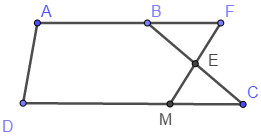
Ta có: M, E, F thẳng hàng nên theo hệ quả của định lí Ta-let ta có: \dfrac{{FE}}{{EM}} = \dfrac{{BE}}{{CE}} = \dfrac{1}{2} hay E là trung điểm của MF. Khi đó
\overrightarrow {MC} = \overrightarrow {BF} = \dfrac{2}{3}\overrightarrow {AB} = \dfrac{2}{3}.\dfrac{1}{2}\overrightarrow {DC} = \dfrac{1}{3}\overrightarrow {DC} = - \dfrac{1}{3}\overrightarrow {CD} .
Vậy x = - \dfrac{1}{3}

